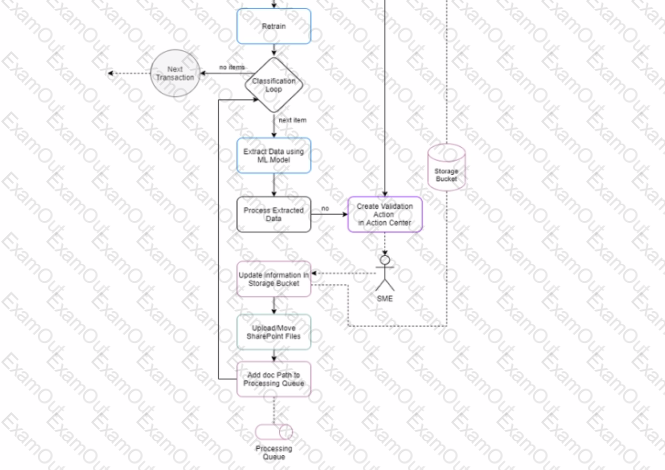Given the High-Level Diagram, what is the best improvement that the Solution Architect should make at the process level?
A Solution Architect created the following estimation for a low-complexity process:
1 Sub-Process3 ComponentsEstimation (days)Q Notes
DispatcherConfig file configuration0.25
System 1
Login/Logout0.25
Navigate to CO report0.125
Extract Data0.25
Orchestrator
Configure assets/queue0.125
Upload queue items0.125
PerformerConfig file configuration0.125
System 1
Login/Logout0.25
Navigate to CO report0.125
Search Person by ID0.125
Person Details - Extract data0.125
Current Performance Details + Extract data0.5
Check Level Info0.1
System2
Create Confirmation file0.1
ReadMNOPfile0.1
System?
Create Confirmation file0.1
Read MNOPfile0.1
Convert MNOPfile data into structured Data0.5
Compare data betweeen files0.5
System 1
Navigate to CO report0.125
Search Person by ID0.125
Update Date & Save0.125
Navigate back to search0.125
Dispatcher/Performer Integration, functional testing2
Dispatcher/Performer General best practices2
Total EstimationAll + Contingency (30%)11.0
Based on the Best Practices a Solution Architect should follow when creating an estimation and having the Solution Design in mind, what is one significant mistake that the Solution Architect made?
Invoices from various clients require processing Why would the "Unique Key" properly be used in the Orchestrator Queue configuration?
How does a Solution Design Document (SDD) contribute to the ongoing success of an RPA solution?
A user is conducting a code review for a project that needs to be executed daily and carries out the following tasks:
- Establish a connection with a department mailbox and filter all unread emails that have "Invoice" in their subject line.
- For every filtered email: - Download all the attachments contained within.
- Mark the email as "Read".
The following image displays the Process.xaml workflow for the Performer process, which was developed using the REFramework:
[J] Process• ft
©
| ► Email Processing\FindEmailsToProcess.xaml * In... ft Filter unread emails with subject containing 'Invoice'
Workflow file name
'Email_Processing\FmdEmailsToProcess.xaml*-
Import Arguments 2 Open Workflow
▼
O For Each Found Email • ft
ForEach_____________________ In
currentEmailEmaiisToProcess
(«] Body • ft
©
► Email. Processing\DownloadAttachmentsFromEmail... • ft Download all attachments from email to appropriate folder
Workflow file name ■Email_Processing\DownloadAnachmentsFromEmail-> «.
Import Arguments 2 Open Workflow
► Email Processing\MarkEmailAsRead xaml I... ft Processing is complete so mark the email as 'Read'
Workflow file name ■Email_Processing\MarkEmailAsReadJ(aml* -
Import Arguments 2 Open Workflow © ©
What is wrong with this design?
What are the permissions required for a document validation user?
In UiPath action central, what happens once an action is generated for a user?
Consider the following high-level solution diagram:

What activity should be used for implementing me Classification Loop according to UiPath Best Practices?
Consider the two Workflows with their descriptions below:
Workflow 1: Select employees onboarded in the last month from a database.
Workflow 2: Navigate to a webpage based on a certain rule.
Which Abstraction Layer do the Workflows belong to?
Which is the best approach to invite 100 users simultaneously to UiPath Automation Cloud?

